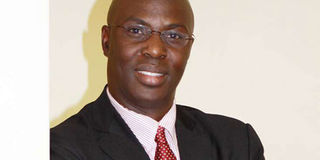Walibora works set to be translated to Chinese language

The late Ken Walibora. File | Nation Media Group
What you need to know:
- Being a Chinese reading Siku Njema (1996) in college was a totally unique experience.
- Walibora’s willingness to be a Mswahili of his own kind did not actually threaten other Swahili literature forms.
It is now three months since Swahili author Ken Walibora passed on. Some weeks ago, I wrote an article in Swahili about his achievements. I am now making a clarion call in English that the great author’s books, over 40 of them, should be utilised as a catalyst of the translation process of Swahili literature to the world.
I am a Chinese scholar of Swahili studies and African linguistics, schooled in Germany, and researching on topics of East Africa.
The great author’s death on April 10, 2020, not only caused immense grief but also raised a debate on what Swahili literature stands for today. The question about “Who are the Swahilis” was very prominent.
There are many readings of the word Swahili. I embody the reading of Swahili as a person with no traceable personal connection with East Africa (and the Central Africa).
SIKU NJEMA
My numerous journeys to East Africa, together with personal encounters with individual odysseys from abroad, can’t help me much. However, I believe that the late author’s life holds some answer for that.
The best way to remember Walibora is through the nicknamed Kongowea Mswahili, a character he created in his first novel Siku Njema (1996). I read this novel from the first page to the last without a break when I was a Swahili student in college. Siku Njema is a smaller novel in pagination compared to others like Shafi Adam Shafi’s Mbali na Nyumbani (2013) or Kyallo Wamitila’s Harufu ya Mapera (2012), but it has remained the most ‘tasty’ book in Swahili for starters.
The story of Msanifu Kombo was really moving. Kombo, as a child, had lost his taarab singer mother Zainabu. He rises to become the Swahili guru Kongowea Mswahili and finally solves his mysterious identity by finding his father.
It is the story of a troubled young man who successfully pulls himself out of the abyss of poverty through his effort, education and humility.
Being a Chinese reading Siku Njema (1996) in college was a totally unique experience. Swahili classes exist in many countries, including in Europe, Asia and the US.
One of the foreign Swahili students’ ideals is that Swahili literature could gain worldwide acknowledgement or at least equal the German, Russian or Japanese literature, according to the number of speakers. However, there is less institutional support.
LITERARY CRITICISM
Established theorists of literary criticism are gatekeepers. By comparing the genres, plots and motifs across different texts, they decided which novels can be grouped together, linked to one another, formed what style circles, and consumed by which people.
At the same time, they refused to pave the way or invest more resources to translate Swahili literature into some major world languages.
On the other hand, there are also foreign theorists who I would even label torchbearers. They have made an impact to preserve the texts of authors by bringing them to the Swahili students. Mr Lourenco Noronha, for instance, a Swahili lecturer in Austria for 35 years (1974-2009), refined a webpage profiling all the classic Swahili writers he introduced to the European readers.
The late Prof Thomas Geider (1953-2010) in Germany compiled a bibliography of Swahili studies in the journal Swahili Forum (2003, 2011) for general interest. The 130 page list, which is also available online, is totally free of charge.
These torchbearers led me to visit the late Ahmed Sheikh Nabhany in his Mombasa home to understand the names of dances and songs. I am also optimistic that scholars are closely following Kyallo Wamitila, Kithaka wa Mberia, Mahmoud Mau, Rocha Chimera, Ahmed H. Ahmed and countless others who are currently pillars of Swahili literature.
Ken Walibora’s popularity worldwide could make his fame in Kenya child’s play. After his funeral, CHAUKIDU (the Global Association for the Development of Swahili) held a special tribute online meeting to celebrate his life. Swahili gurus and many enthusiasts revisited what a good job Walibora, a great Mswahili and the first president of CHAUKIDU, did to promote Kiswahili language.
SWAHILI LITERATURE FORMS
Walibora’s willingness to be a Mswahili of his own kind did not actually threaten other Swahili literature forms. Actually he tried to provide spaces (rightful places) for the literature works of other Swahilis. His earliest critical work set the goals of understanding the poetry of Sauti ya Dhiki (1973), a composition of the great Mombasa poet Abdilatif Abdalla.
The last time I met Walibra was last year, at the gate of his house in Nairobi, when Ken called me “mkubwa” and then handed me his book meant for grade one pupils - Kalamu ya Maria Imepotea (2019). I was surprised by his generosity.
A few months ago, a scholar from CASS (China Academy of Social Sciences) asked me how to translate the late Ken Walibora’s novel Siku Njema (1996) into Chinese. I have a copy of the English translation, A Good Day (2019)’, a gift by him during a conference of CODESRIA (Council for the Development of Social Science Research in Africa). The scholar wanted me to do some crosschecking from the Swahili original and was shocked when Walibora’s death interrupted the collaboration.
“I’m sorry for the loss, let’s see what we can do,” I replied.
Yuning Shen is a researcher (ZJNU, China), PhD candidate (UHH, Germany) and visiting/co-teacher (University of Nairobi). Email: [email protected]




